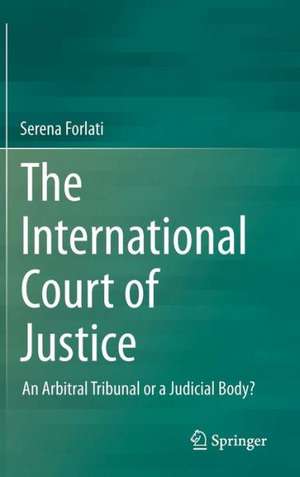The International Court of Justice: An Arbitral Tribunal or a Judicial Body?
Autor Serena Forlatien Limba Engleză Hardback – 7 iul 2014
However, the permanent nature of the Court, the predetermination of procedural rules by the Statute and the Rules of Court, the public character of proceedings, the opportunity for third States to intervene in a case under Articles 62 and 63 of the Statute and the Court's role as the principal judicial organ of the United Nations mark a structural difference between the ICJ and non-institutionalized international arbitral tribunals.
This book analyses if and to what extent these features have influenced the approach of the ICJ (and of the PCIJ before it) to its own judicial function and have led it to depart from the principles established in international arbitration.
| Toate formatele și edițiile | Preț | Express |
|---|---|---|
| Paperback (1) | 556.90 lei 38-44 zile | |
| Springer International Publishing – 23 aug 2016 | 556.90 lei 38-44 zile | |
| Hardback (1) | 644.49 lei 43-57 zile | |
| Springer International Publishing – 7 iul 2014 | 644.49 lei 43-57 zile |
Preț: 644.49 lei
Preț vechi: 758.23 lei
-15% Nou
Puncte Express: 967
Preț estimativ în valută:
123.32€ • 129.09$ • 102.64£
123.32€ • 129.09$ • 102.64£
Carte tipărită la comandă
Livrare economică 31 martie-14 aprilie
Preluare comenzi: 021 569.72.76
Specificații
ISBN-13: 9783319061788
ISBN-10: 331906178X
Pagini: 190
Ilustrații: XIII, 235 p.
Dimensiuni: 155 x 235 x 20 mm
Greutate: 0.53 kg
Ediția:2014
Editura: Springer International Publishing
Colecția Springer
Locul publicării:Cham, Switzerland
ISBN-10: 331906178X
Pagini: 190
Ilustrații: XIII, 235 p.
Dimensiuni: 155 x 235 x 20 mm
Greutate: 0.53 kg
Ediția:2014
Editura: Springer International Publishing
Colecția Springer
Locul publicării:Cham, Switzerland
Public țintă
ResearchCuprins
Introduction.- Introduction to Part I.- The ICJ’s Power to Adopt Rules of Court and Practice Directions.- The Composition of the Bench in Particular Cases.- The Representation of the Parties before the ICJ.- The Organisation of Contentious Proceedings.- The Adoption of Provisional Measures under Article 41 of the Statute.- Conclusions to Part I.- Introduction to Part II.- Judgments infra Petita.- Judgments ultra Petita.- Conclusions to Part II.- Introduction to Part III.- Intervention under Article 63 of the Statute.- Intervention under Article 62.- Conclusions to Part III .- Conclusions.
Textul de pe ultima copertă
The International Court of Justice is the principal judicial organ of the United Nations, and epitomizes the very notion of international judicial institution. Yet, it decides inter-State disputes only with the parties’ consent. This makes it more similar to international arbitral tribunals than other international courts.
However, the permanent nature of the Court, the predetermination of procedural rules by the Statute and the Rules of Court, the public character of proceedings, the opportunity for third States to intervene in a case under Articles 62 and 63 of the Statute and the Court's role as the principal judicial organ of the United Nations mark a structural difference between the ICJ and non-institutionalized international arbitral tribunals.
This book analyses if and to what extent these features have influenced the approach of the ICJ (and of the PCIJ before it) to its own judicial function and have led it to depart from the principles established in international arbitration.
However, the permanent nature of the Court, the predetermination of procedural rules by the Statute and the Rules of Court, the public character of proceedings, the opportunity for third States to intervene in a case under Articles 62 and 63 of the Statute and the Court's role as the principal judicial organ of the United Nations mark a structural difference between the ICJ and non-institutionalized international arbitral tribunals.
This book analyses if and to what extent these features have influenced the approach of the ICJ (and of the PCIJ before it) to its own judicial function and have led it to depart from the principles established in international arbitration.
Caracteristici
Carefully analyses the practice of the Permanent Court of International Justice and of the International Court of Justice Compares the role of the ICJ with the one of international arbitral tribunals Contributes to the understanding of the international judicial function more generally













